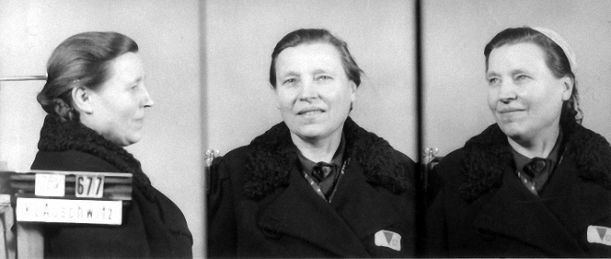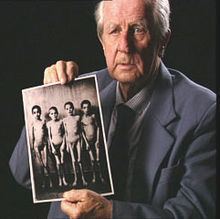Nationality Polish Name Wilhelm Brasse | Role Photographer | |
 | ||
Born 3 December 1917 ( 1917-12-03 ) Zywiec, Partitioned Poland Occupation Photographer (1940–1945) Known for Photography done under duress as inmate of KL Auschwitz-Birkenau Died October 23, 2012, Zywiec, Poland Children Lidia Brasse, Jerzy Brasse Books Wilhelm Brasse: fotograf, 3444, Auschwitz, 1940-1945 | ||
Wilhelm brasse presentation introduction
Wilhelm Brasse (3 December 1917 – 23 October 2012) was a Polish professional photographer and a prisoner in Auschwitz during World War II. He became known as the "famous photographer of Auschwitz concentration camp"; his life and work were the subject of the 2005 Polish television documentary film The Portraitist (Portrecista), which first aired in the "Proud to Present" series on the Polish TVP1 on 1 January 2006.
Contents
- Wilhelm brasse presentation introduction
- Fotografowa piek o wilhelm brasse
- Personal history
- The Auschwitz photographs
- Documentary film The Portraitist
- Work of art based on Brasses photographs
- Filmography
- References

Brasse was of mixed Austrian-Polish descent. He learned photography in Katowice at the atelier of his own aunt. After the 1939 German invasion of Poland and occupation of Brasse's hometown Żywiec, in southern Poland, he was interrogated by the Schutzstaffel (SS). He refused to swear allegiance to Hitler, and was imprisoned for three months. After his release, still refusing to capitulate to the Volksliste and forced membership of German Army, he tried to escape to Hungary and join the Polish Army in France but was captured, along with other young men, at the Polish–Hungarian border and deported to KL Auschwitz-Birkenau as prisoner number 3444. Trained before the beginning of World War II as a portrait photographer in Silesia, he was ordered by the SS camp administrators to photograph "prisoners' work, criminal medical experiments, [and] portraits of the prisoners for the files." Brasse has estimated that he took 40,000 to 50,000 "identity pictures" from 1940 until 1945, before being moved to another concentration camp in Austria, where he was liberated by the American forces in May 1945.

While many of Brasse's photographs did not survive, some are on display in the Auschwitz-Birkenau State Museum and at Yad Vashem, the Holocaust Martyrs' and Heroes' Remembrance Authority, Israel's official memorial to the Jewish victims of the Holocaust. His photographs inspired Painting Czesława Kwoka (2007), which won a literary award.

Fotografowa piek o wilhelm brasse
Personal history

Wilhelm Brasse was born on 3 December 1917 to a descendant of Austrian colonists and a Polish mother in Żywiec, in the Partitioned Poland. His father was a Polish soldier in the Polish–Soviet War of 1919–1921. Wilhelm Brasse was "trained as a portrait photographer in a studio owned by his aunt" in Katowice, and "had an eye for the telling image and an ability to put his subjects at ease."

After the September 1939 invasion of Poland, he was pressured by the Nazis to join them, refused, was repeatedly interrogated by the Gestapo, and tried to escape to France via Hungary, but he was captured at the Polish-Hungarian border and incarcerated for four months. After continuing to refuse to "declare his loyalty to Hitler", on 31 August 1940, he was deported to Auschwitz concentration camp, soon after it opened.
In February 1941, after having been called to the office of Rudolf Hoess, Auschwitz's commander, along with four others, and tested for "photographic skills", he was selected specifically for his "laboratory skills" and "technical ability with a camera" and for his ability to speak German, and then ordered to document the Nazi prisoners in the camp in the "Erkennungsdienst, the photographic identification unit." A year and a half later, Brasse encountered Josef Mengele, the notorious Nazi doctor who "liked" his photographs and wanted him to photograph some of the twins and people with congenital disorders moved to his infirmary on whom Mengele was "experimenting". After the Soviets entered Poland, during the Vistula-Oder Offensive, from 12 January to 2 February 1945, along with thousands of other Auschwitz prisoners, Brasse was forcibly moved to Austria, to the concentration camp in Ebensee, a subcamp of the Mauthausen-Gusen concentration camp complex (the last remaining in the area still controlled by the Nazis), where he remained imprisoned until the American forces liberated him in early May 1945.
After returning home to Żywiec, a "few miles from" KL Auschwitz-Birkenau, Brasse tried to start "taking pictures again", but, traumatized, he found himself haunted by the "ghosts" of the "dead" – the subjects of his tens of thousands of Auschwitz pictures – and unable to resume his work as a portrait photographer, he ultimately established what would become a "moderately prosperous" sausage casing business.
Although he had gone back to the State Museum at Auschwitz-Birkenau, "to talk with visitors about his experiences", and although he still possessed a "small pre-war Kodak" camera, he would "never take another photograph."
He died in Żywiec, at the age of 94. He was married with two children and five grandchildren, and lived with his wife until his death. His death was announced by an Auschwitz-Birkenau State Museum historian.
The Auschwitz photographs
Trained before the beginning of World War II as a portrait photographer at his aunt's studio, he was ordered by his SS supervisors to photograph "prisoners' work, criminal medical experiments, [and] portraits of the prisoners for the files." Brasse has estimated that he took about 40,000 to 50,000 "identity pictures" from 1940 until 1945, before being forcibly moved to another concentration camp in Austria, where he was liberated by the American forces in early May 1945.
Dr. Mengele had insisted that Brasse take the "identity" portraits of Auschwitz prisoners "in three poses: from the front and from each side." After taking hundreds of thousands of such photographs, Brasse and others disobeyed later Nazi orders to destroy them, yet only some of his photos have survived:
although it is hard to say which were Brasse's, since camp photos as a rule didn't carry the photographer's name[,] ... Jarosław Mensfelt, spokesman of the Auschwitz-Birkenau museum, says some 200,000 such pictures were taken, with name, nationality and profession attached. ... About 40,000 of these pictures are preserved, some with the identification cards, and 2,000 of these are on display in the museum.... others are at Yad Vashem, the Israeli Holocaust memorial.
Some photographs credited to Brasse are in the Auschwitz-Birkenau State Museum's permanent exhibit in Block no. 6: Exhibition: The Life of the Prisoners. All visitors to the Museum are asked explicitly to respect the Site of the Death Camp and not to use cameras (both still and video) in its indoor exhibits.
Similar individual "identification photographs" or "mug shots" of prisoners of Auschwitz and other German concentration camps are accessible in the searchable online Photo Archives of the United States Holocaust Memorial Museum (USHMM); biographical-information cards including these photographs and each corresponding to a concentration-camp inmate are also distributed to Holocaust Memorial Museum visitors as they enter. Partially featured on the USHMM official Website is a photograph of the photo mural on a wall of its 3rd floor permanent exhibit. A photograph of an adult female Auschwitz inmate by Wilhelm Brasse is accessible from the USHMM Photo Archives. The USHMM official Website also features similar "identification photographs" credited to the "National Auschwitz-Birkenau Museum" (the Auschwitz-Birkenau State Museum, Poland), but without identifying the photographer (who may or may not be Brasse), as illustrations in "Persecution of Homosexuals in the Third Reich".
Documentary film: The Portraitist
This 52-minute Polish documentary film about his life and work, entitled The Portraitist (Portrecista, Poland, 2005), directed by Irek Dobrowolski, and produced by Anna Dobrowolska, was first shown on Polish television station TVP1 on 1 January 2006, in the "Proud to present" series, and it premiered at West London Synagogue, in London, on 19 March 2007, with a second screening by popular demand, on 22 April 2007. In the film Brasse relates the "story behind some pictures in the Auschwitz museum archives that he remembers taking."
As the synopsis for the film emphasizes, after taking thousands of photographs from 1940 until 1945, and, with "courage and skill", documenting "cruelty which goes beyond all words ... for future generations", Brasse "could not continue with his profession...."
Fergal Keane concurs that "Brasse has left us with a powerful legacy in images. Because of them we can see the victims of the Holocaust as human and not statistics. ... The photographs are the work of a man who fought to keep his humanity alive in a place of unimaginable evil."
Work of art based on Brasse's photographs
Among Brasse's photographs of children concentration-camp prisoners exhibited in the Auschwitz-Birkenau State Museum, in Poland, "identity pictures" of Czesława Kwoka attributed to him inspired a collaborative mixed-media artwork entitled Painting Czesława Kwoka, by Theresa Edwards (verse) and Lori Schreiner (art), which was displayed at the Windham Art Gallery in Brattleboro, Vermont, from 1 June to 1 July 2007, as part of the exhibition Words & Images: A Collaboration. According to the artists' exhibition catalogue statement, it "brings Czeslawa's image and voice into our lives," thus memorializing Kwoka and all child victims of the Holocaust, as well as others who lost their lives as a result of war. After being featured in the online journal AdmitTwo, in September 2007, it received the 2007 Tacenda Literary Award for Best Collaboration, from BleakHouse Publishing.
